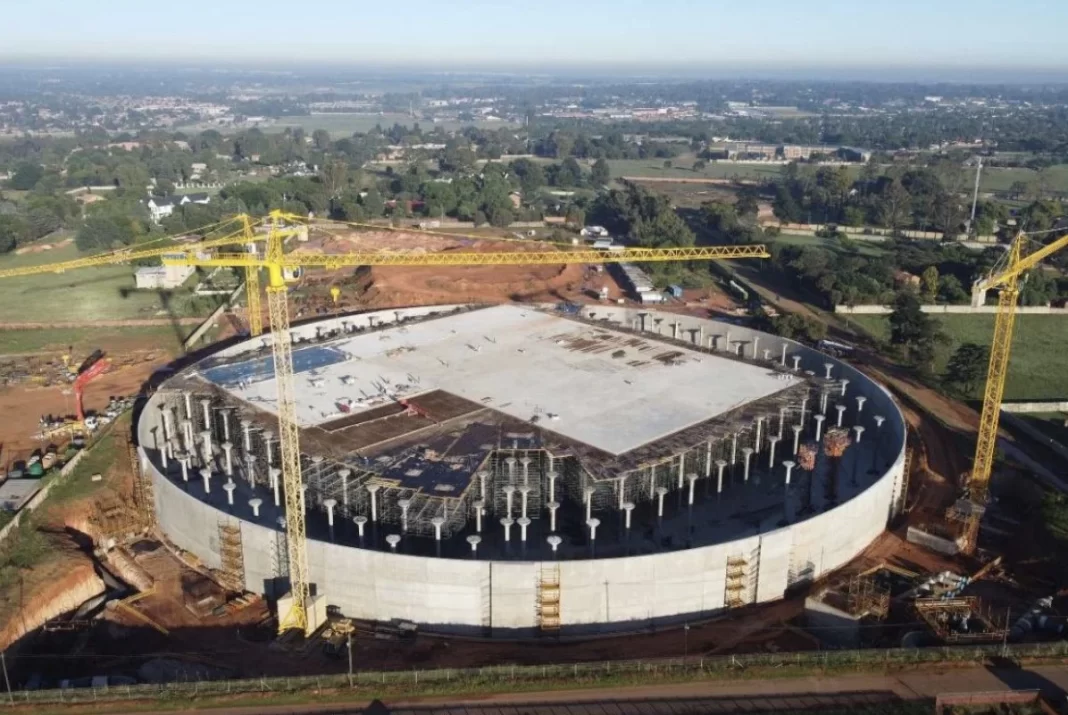WATER utility Rand Water has announced the launch of a new ‘mega reservoir’ in the City of Ekurhuleni, Gauteng.
According to the utility, the newly-built 210 megalitre Vlakfontein Reservoir is the largest cylindrical and circular reservoir in South Africa, and one of the biggest in the world.
At 210 megalitres, the reservoir can hold enough water to fill 84 Olympic-size swimming pools, which average around 2.5 megalitres.
Speaking with SAfm, Sipho Mosai, the chief executive of Rand Water, said that the new development is an engineering marvel that will assist with providing water to areas affected by shortages.
The executive said that the water supply in Gauteng has been facing constant challenges in light of continual rolling blackouts.
Mosai said that the new reservoir will now give an additional 24-hour water buffer for areas that are affected by water outages when pumps in the Tshwane or Pretoria area lack the necessary power.
The reservoir is the biggest post-tension reservoir in the world at 210 megalitres, higher than the second biggest in Saudi Arabia, which reaches 200 megalitres, he added.
Post-tensioning is a technique that uses steel cables to apply tension to hardened concrete, increasing its strength and durability.
According to water and sanitation minister Senzo Mchunu, the size of the reservoir means that it can hold enough water to provide for 24 hours, in case of challenges with pumping.
The minister appealed to other provinces to introduce similar mitigation projects and measures, adding that the department is working with local authorities to ensure that all regions are ‘looked after’, and water is available.
Rand Water said that 13 new reservoirs are planned for or are already under construction. The group said that water can be load shifted between the various systems, which should help during times of crisis.
HKG Consulting, which was involved with the project, noted some technical aspects of the build:
The reservoir has an inner diameter of 154 metres and a wall height of 11.8 metres. The reservoir is covered by a flat slab roof supported by 256 columns spaced at 8.4 metres.
“Since the reservoir is 6 metres below natural ground level, both a leakage detection system and a ground water drainage system, separated by a reinforced flexible polypropylene liner, is provided underneath the complete footprint of the reservoir,” the group said.
Construction on the reservoir started in 2015, with the official completion date targetted for mid-2023.
“This is probably one of the largest cylindrical post-tensioned concrete reservoirs in the world,” it said.
Load shedding and vandalism
South Africa’s water infrastructure is under immense pressure due to load shedding, adverse weather conditions and a lack of proper maintenance.
Of these issues, load shedding is currently the most egregious problem. Vandalism of critical electricity infrastructure has been having unprecedented effects on water pumps in Gauteng, Mosai said.
He said that an increase in this type of crime had prolonged the time it takes for water pumps to come back online because the municipality and Eskom itself have to complete assessments before moving on.
Mosai said that in some cases, stations could not pump for 12 hours because of the vandalism. He added that it takes longer for pumps to come back into operation as they are switched on in multiple stages – increasing the time it takes to get back to full capacity.
Systems have also come under pressure in recent months, particularly in Gauteng, amid heat waves and extended periods of dry weather in the latter months of 2022.
Municipalities have been working to upgrade infrastructure with Rand Water, which has also resulted in extended periods of outages while maintenance is done. One such period is planned for the City of Tshwane in February.
The City of Tshwane has alerted residents that Rand Water will be shutting down a key pipeline for maintenance later in February, which will lead to zero water supply to certain areas for around 30 hours.
The shutdown is planned to complete tie-ins of the newly installed S4 water supply, which saw outages in regions across Gauteng in 2022.
The work will take place from 03h00 on Friday, 24 February 2023, and continue until 09h00 on Saturday, 25 February 2023.
Business tech

